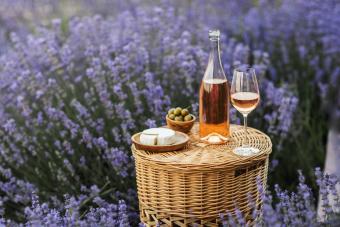
Some winemakers in cooler regions turn to chaptalization, the process of adding additional sugar to wine (enriching it) in order to further fermentation and create a wine with higher alcohol by volume (ABV). Chaptalization is not legal everywhere, but some winemakers use it legally in their wine production.
Understanding Chaptalization
Chaptalization (chap-tuh-lie-zay-shun) is also known as sugaring, amelioration, or enrichment, and it's named after the French chemist who invented the process, Jean-Antoine-Claude Chaptal. In order to ferment wine, you need two things: sugar and yeast. Wine grapes contain natural sugars that, when they come in contact with either naturally occurring yeasts or added yeast, will ferment into alcohol and carbon dioxide. Even the wine grapes used to make very dry wines contain a significant amount of sugar that interacts with yeast to ferment into alcohol. When fermentation stops early (either through intervention or because the grapes run out of sugars to ferment), then the ABV tends to be fairly low.
Cool Weather Climates Create Low-Sugar Grapes
Some climates with cooler weather produce grapes that are naturally lower in sugar than their warm weather counterparts. As a result, these grapes are under-ripe and have lower sugar content (called brix) to ferment, which means the resulting wines will be lower in alcohol. In lighter wines, this isn't an issue, but in medium-bodied to full-bodied wines, insufficient alcohol leaves them out of balance and unappealing.
Adding Sugar Adds Alcohol, Not Sweetness
Enter chaptalization. Essentially, this is the technique of adding a specific amount of sugar to the must (freshly crushed juice) in order to raise the brix and provide more sugar for fermentation. The result isn't a sweeter wine (unless the fermentation is deliberately halted); it is a higher alcohol wine. Very dry wines can result from the chaptalization process.
The Chaptalization Process
Winemakers add sugar to must from low-brix wine grapes before fermentation occurs. Most measure the brix in the grapes and then enrich the must with the appropriate dosage of sugar based on a specific chaptalization calculator. The sugar is most commonly cane sugar, although winemakers may also add beet sugar or corn syrup. In some cases, winemakers may also add grape concentrate for the same purpose, although this isn't considered chaptalization and is legal even in regions where chaptalization isn't. Then, the wine is allowed to ferment as normal until the sugar has been consumed by yeast and turned into alcohol. It should be noted that chaptalization is different from dosage, in which sugar is added to Champagne that has already been fermented in order to increase sweetness.
Chaptalization Isn't Legal Everywhere
Wine chaptalization isn't legal everywhere. Some winemakers feel it gives growers in less than ideal regions an advantage in the marketplace. In 1907, wine growers in France's Languedoc region revolted, in part because of some winemaking processes including adding sugar to wine. This led the French government to strictly regulate how much sugar winemakers could add to wine. Regions where chaptalization is illegal include California, Australia, Italy, Argentina, Greece, South Africa, Portugal, Austria, and Spain. Chaptalization is legal in Oregon, Canada, Chile, Bordeaux, Burgundy, Alsace, Champagne, Germany, New York, China, Switzerland, and New Zealand. In Europe where chaptalization is allowed, the EU sets limits for how much sugar can be added based on where the wines are grown resulting in anywhere from 1.5% to 3% ABV increases.
Enriching Wine With Chaptalization
It is unlikely you will be able to tell which wines have undergone chaptalization simply by tasting them. Chaptalization is one way winemakers can ensure more consistent results. By adding a small amount of sugar to the must, it has adequate sugars for the yeast to ferment in order to produce a balanced and pleasing wine. While it isn't necessary in warm weather grape growing climates, in cooler weather climates it can make a huge difference in the finished product.







